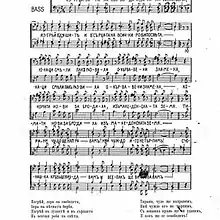March of the Macedonian Revolutionaries
The "March of the Macedonian Revolutionaries" (Bulgarian: „Марш на македонските революционери“) (Macedonian: „Марш на македонските револуционери“) also known as "Rise, Dawn of Freedom"; (Bulgarian: „Изгрей зора на свободата“) (Macedonian: „Изгреј зора на слободата“) is a Bulgarian march which was used by the Internal Macedonian Revolutionary Organization (IMRO), the Macedonian Patriotic Organization (MPO) and was shortly the anthem of the Socialist Republic of Macedonia before the adaptation of the Today over Macedonia anthem.[1] Today, the march is still used by the MPO, as well as by VMRO-BND and the Radko Association.[2][3][4][5]
| "March of the Macedonian Revolutionaries" | |
|---|---|
 | |
| Song by Aleksandar Morofov | |
| Language | Bulgarian |
| Written | 1923 |
| Published | 1925 |
| Songwriter(s) | Aleksandar Morfov |
History
The lyrics and music of the march were written by Aleksandar Morfov, a Bulgarian military composer in 1923 at a contest by the IMRO. The proposed march was presented to the leader of IMRO, Todor Alexandrov by the composer at the home of General Kosta Nikolov in Sofia.[6] In the period before World War II, the march was performed as the official anthem of the IMRO.[7] The poet Kočo Racin tried to adapt the chorus of the song to the still non-standardized Macedonian language shortly before his death in 1943.[8]
The first Anti-fascist Assembly for the National Liberation of Macedonia meeting, held on August 2, 1944, at the Prohor Pčinjski Monastery was opened with the singing of the song. After the Tito-Stalin split in 1948, the song was banned by the Yugoslav and Macedonian communist authorities as anti-patriotic and pro-Bulgarian.[5] Today, there is reserved attitude towards this song in North Macedonia.[9]
On August 2, 2017, during a service commemorating the Ilinden Uprising, the monks from the Saint Jovan Bigorski Monastery in Republic of Macedonia, performed the song, expressing their approval of the friendship treaty signed with Bulgaria the day before.[10] Afterwards the song continued to be performed there on 2 August, to commemorate the Ilinden Uprising.[11]
References
- Как е създаден химнът "Изгрей, зора на свободата", Петър Иванчев, сп. България - Македония, брой 1, 2015 г.
- "Символи -" (in Bulgarian). Retrieved 2022-10-16.
- "Association RADKO". 2009-02-07. Archived from the original on 2009-02-07. Retrieved 2022-10-16.
- Macedonian Patriotic Organization, Convention.
- Aleksandar Pavković; Christopher Kelen (2016). Anthems and the Making of Nation States: Identity and Nationalism in the Balkans. I.B. Tauris. pp. 164–165. ISBN 9781784531263.
- Вдъхновение, Петър Иванчев, „Изгрей, зора на свободата" в сп. България - Македония, бр. 4-5, 2017 г.
- Михайлов, Иван. "Quo vadis, Bulgaria?", I изд. Индианаполис, Печатница “Македонска трибуна”, 1937, II изд. ИК “Витатон”, Пещера, 1996, стр. 35-44.
- Во јуни 1943 год. маршот „Изгреј зора на слободата“ бил поместен на челното место во првата збирка „Македонски народно - ослободителни песни“, подготвена од поетот и револуционер Кочо Рацин и отпечатена во партизанската печатницата „Гоце Делчев.“ For more see: Glasnik, Том 48, Issues: 1–2, Institut za nacionalna istorija (Skopje, Macedonia), 2004, p. 30.
- Иван Блажевски, "Забранетата песна ги бранува духовите. „Изгреј зора“ била бугарска и фашистичка песна", "Време", броj 310, 09. 02. 2005.
- Вистината ќе ве ослободи, Порталот Поглед разговараше со Игуменот на манастирот Св Јован Бигорски – Отец Партениј. Бигорски манастир. 28 октомври/10 ноември 2017 лето Господово.
- "ЗА ИЛИНДЕН ВО БИГОРСКИ МАНАСТИР: Молитва за татковината и химната на Македонија | † Бигорски манастир". bigorski.org.mk (in Macedonian). Retrieved 2023-09-01.
External links
- "Rise up Dawn of the Freedom" on YouTube.
- „Изгрей зора на свободата“ on YouTube, performed by the monks of Saint Jovan Bigorski Monastery on 2 August 2017 during a service in memory of the Ilinden Uprising.
- The text of the song in Bulgarian Cyrillic with transliteration in Latin script.